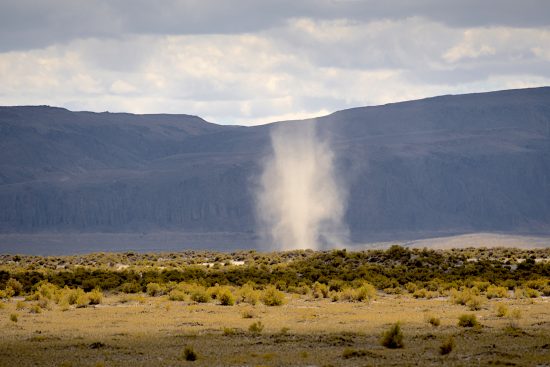
Sep 20, 2019
Electrical activity occurs in every environment.
Charged plasmas are seen rising from several planets and moons in the Solar System. Io, for example, Jupiter’s pugnacious and violent moon, discharges plumes that extend hundreds of kilometers into space. The Cassini mission discovered ionized vapor erupting from the south pole of Enceladus. Whorls of dust, or “dust devils”, imaged by rovers on the Martian surface, were discussed in previous Pictures of the Day.
Some of the dust devils on Mars are higher than Mt. Everest, drawing dust up through thousands of funnels. In such disparate environments, between Io and Mars, for instance, the common factor for those phenomena is most likely electrical in nature.
According to a recent press release, associate professor Brian Jackson from Boise State University said:
“When we compare theoretical predictions of how much dust a devil should lift to how much it does lift, the numbers just don’t add up.”
Since the atmospheric density on Mars is less than one percent that of Earth, how can wind carve the soil and leave multiple tracks that can be seen from space? Massive dust storms sometimes engulf an entire hemisphere on Mars. Synchrotron radiation is detected at the tops and bottoms of the tornado-like whirlwinds that aggregate into structures that can encompass tens of thousands of square kilometers.
Using the formula q=0.5ρv^2, where q is the pressure, ρ is the density of the atmosphere and v is the wind velocity, the dynamic pressure of a 97 kilometer per hour wind on Mars is equivalent to that from a 12 kilometer per hour wind on Earth. Even the most intense winds on Mars exert a small fraction of the force that is experienced here. So, what energizes the global dust storms in such a rarified vapor of frigid carbon dioxide gas?
Several years ago, NASA conducted dust devil research in the Arizona desert. Atmospheric scientists claimed that “saltation” generated the electric fields that were discovered in the dust devils of Arizona. Saltation means “the intermittent, leaping movement of sand and gravel particles from the force of wind or running water”. In other words, sand particles are supposed to create electric charges close to 10,000 volts per meter by rubbing against each other.
Since Mars has no thunderstorms to “charge-up” its ionosphere, it makes a good case study for Electric Universe theory. An electrical model predicts that the Martian ionosphere is already charged, so electrical effects reach directly from the ionosphere to the surface without the ameliorating effects of storm clouds like those on Earth. Since electrical energy can accumulate in a “planetary capacitor” for some time, there is the potential for planetary-scale events when the atmosphere finally discharges.
In an Electric Universe, no collisions from bouncing sand grains are necessary. Charge separation already exists in the atmosphere. Without clouds like those on Earth to send lightning down to ground level, the electric discharges on Mars form giant whirlwinds that are part of an interplanetary electric circuit. It is the kind of circuit that drives weather systems on Earth. If that is true, then Martian “dust devils” and those on Earth are both illustrations of how electricity behaves in the Solar System.
Stephen Smith
The Thunderbolts Picture of the Day is generously supported by the Mainwaring Archive Foundation.












